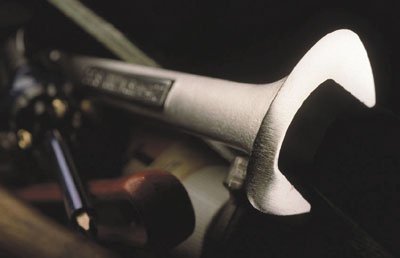What fuels the inventive spirit? If the old saying is right,
it’s necessity. And nothing proves that better than the everyday
works of genius created by hard-working blacks a century ago, still
being used today.
Courtesy of McClatchy
What fuels the inventive spirit?
If the old saying is right, it’s necessity. And nothing proves that better than the everyday works of genius created by hard-working blacks a century ago, still being used today.
“When you think about African-Americans,” said Frederick Douglas Stubbs, an assistant curator at the Detroit Historical Museum for the past 21 years, “… they did all kinds of work. They were blacksmiths, mechanics – they had to come up with innovative ideas to make their jobs easier. They saw a need for these things and sat down to create.
“The trouble is,” Stubbs added, “they didn’t get credit for their creation. A lot of it dealt with racism – that a black man was not smart enough to create or come up with an idea.”
In that case, Black History Month would seem to be a necessity, a ritual way to give credit where it’s due. So take a few minutes to thank silently these four gentlemen for their important work, and to celebrate the inventive spirit, a creative force that’s proved indestructible, even when repressed beyond all measure.
JACK JOHNSON
Jack Johnson became the heavyweight boxing champion of the world in 1908. A few years later, he became a prison inmate, victim of a law used to prevent a black man from traveling with a white woman. He was convicted of taking his girlfriend, Lucille Cameron, across state lines for “immoral purposes.” Johnson left for Europe with Cameron, now his wife. When he returned to the United States he was sent to Leavenworth Federal Prison in Kansas. There, with time on his hands, Johnson created a tool to tighten or loosen fastening devices. It’s changed some over the years, but in 1922, the patent office issued 1,413,121 to Johnson for the wrench.
GEORGE GRANT
Before George Grant of Boston came along, golfers usually got their hands dirty at the start of each hole, mounding soil on which to place the ball. Grant, a dentist who loved the game, invented the wooden tee in 1899. As he told the U.S. Patent Office, “This invention has for its object the production of a simple, cheap and effective tee for use in the game of golf, obviating the use of the usual conical mounds of sand or similar material formed by the fingers of the player on which the ball is supported when driving off.” He received patent 638,920 on an item unchanged now for a century after millions of uses.
WILLIAM PURVIS
Tired of carrying around an inkwell to dip his pen into when it ran dry, William Purvis of Philadelphia invented a pen that holds the ink inside. He told the patent office, “The object of my invention is to provide a simple, durable and inexpensive construction of a fountain pen adapted to general use and which may be carried in the pocket … also provide an elastic ink-feeding tube between the reservoir and pen with a pressure point carried by the holder to compress with elastic tube with each downward stroke of the pen, so as to expel a small quantity of ink from the reservoir outlet in a positive manner.” Purvis patented other inventions, from a bag fastener to a hand stamp.
GARRETT MORGAN
As the automobile became popular in the early part of last century, intersections became more dangerous. Garrett Morgan of Cleveland saw this one day in 1922, when a car hit a horse and carriage, leaving the motorist unconscious and the horse injured. Morgan, who eight years earlier had patented a breathable device now known as a gas mask, went to work on a way to direct traffic. He later told the patent office, “One of the objects of my invention is the provision of a visible indicator which is useful in stopping traffic in all directions before the signal to proceed in any one direction is given.”













